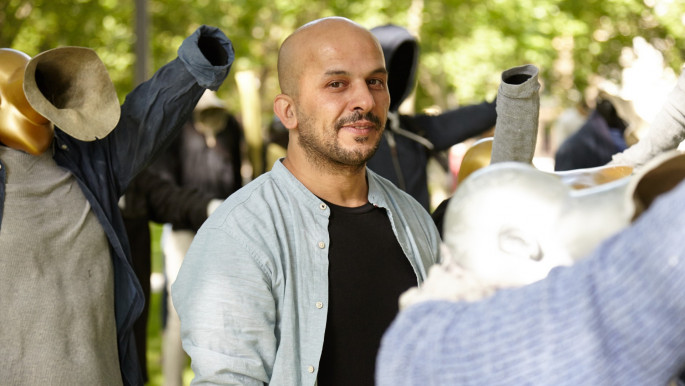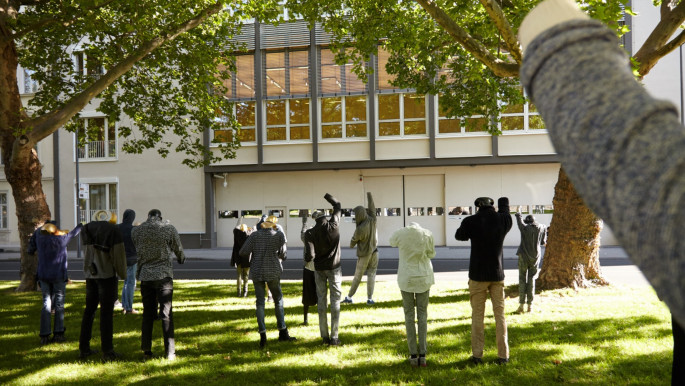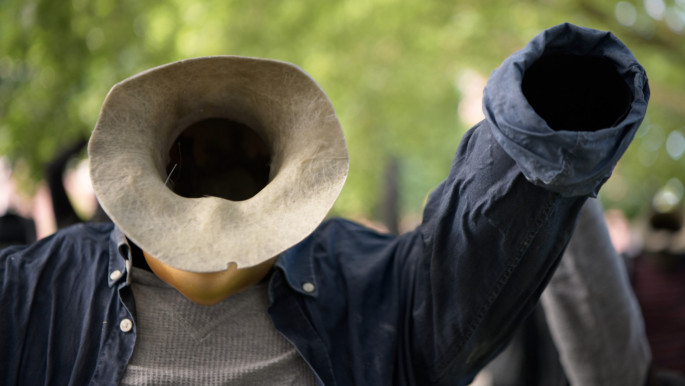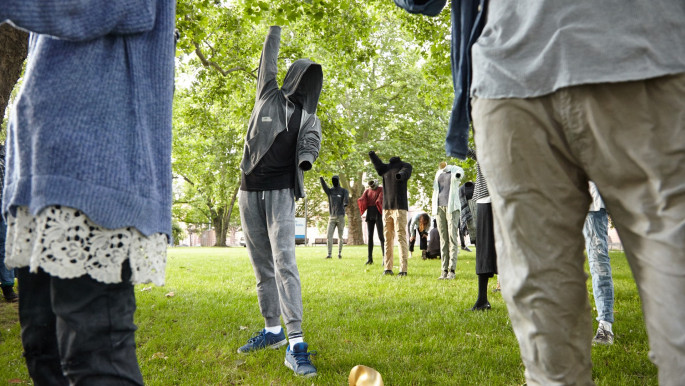'Mute': A Syrian protest that is louder than words
Forty-nine faceless sculptures occupy a patch of grass in the western German city of Koblenz, defiantly raising their fists to the sky as if frozen in mid-chant.
The anonymous figures, some wearing hoods, stand facing a courthouse where one of the most important trials in recent Syrian history is taking place.
In the dock are two suspected members of Bashar Al-Assad's feared security forces, Anwar R. who is accused of torturing thousands of detainees - resulting in 58 murders - and Eyad A., who allegedly tortured at least 30 people.
The two men have been charged with crimes against humanity due to their alleged role in the regime's widespread crackdown against peaceful protesters in 2011.
Many were taken to the notorious General Intelligence Al-Khatib Branch in Damascus where the defendants allegedly worked.
Berlin-based Syrian conceptual artist Khaled Barakeh is behind 'Mute', the powerful two-day installation that seeks to remember those who have lost their lives fighting for freedom in Syria and for the activists continuing this cause.
"We are trying to capture that moment in Syria when people went on demonstrations, peacefully. That is what we are re-creating here, it is a continuation of the work of these amazing activists who risked or lost their lives," Barakeh told The New Arab.
"[We are] saying to the court that we are here, and we want justice."
 |
The idea for the installation began during the long weeks of isolation in Germany when Covid-19 social distancing measures were put in place, producing obvious barriers for activists - such as Barakeh - to practice their right to protest.
"During this time the trial in Koblenz was beginning so, because of these measures, there was no chance for the families to go to the court and be part of that trial, even though it's their trial and their right. So I thought how can we bring people back to the public space while respecting the public health regulations," the artist commented.
Barakeh sent a request to the Syrian diaspora and activists to donate their clothes for the installation.
He transformed these clothes and mannequins into human forms that represented the protesters who took part in anti-regime demonstrations from 2011.
The movements of the dummies' limbs are locked in active and steadfast poses, symbolising the flash protests that took place in Damascus in 2011 when activists would suddenly appear and hold brief demonstrations in public spaces before disappearing into the city.
The absence of the bodies and faces of the models symbolise those activists, many of whom were disappeared by the regime and cannot be present to witness this moment of justice in Koblenz.
"They become more symbolic of the people who wanted to come here, for the people who lost their lives, and for all those still in prison to say we are here, we are witnessing this and part of it," Barakeh added.
 |
| [Adam Broomberg] |
The two defendants have acknowledged the artwork from a distance but have so far not interacted with it or the activists.
The lawyers have been spotted taking pictures of the artwork from the first-floor courtroom above but have maintained a judicial distance from the installation.
Dozens of Syrian activists have stood outside the courtroom handing out flyers to curious passers-by who have moved between the figures and asked questions about the case.
"[The Koblenz locals] have been amazing, I didn't expect this at all. People have been really curious, they have stopped, they have asked questions, they have discussed, and sometimes they debate in long discussions which is exactly what this piece is about," the artist remembers.
"Lots of people are stopping, asking questions, and taking pictures. Some people are asking how they can donate or support [us], so it really was overwhelming in a good sense."
 |
| [Adam Broomberg] |
Along with The Syria Campaign, Families For Freedom have also been involved in the installation.
This women-led civil society group has fought a years-long campaign for justice and answers for family members who were disappeared by the Assad regime.
"They were amazing, they were part of the action and supporters of the project," said Barakeh.
"We came together today so we could support them and they could support us and it was very emotional to see the community gather around the same thing which made us all come together in 2011 when we asked for freedom, dignity and justice."
 |
| [Adam Broomberg] |
"It means so much to see artists making work that recognises the heroic power of Syrian activists. The moment I saw the installation I recalled memories of the demonstrations in Syria in 2011. I recalled the fear that the security forces might come to arrest us," Mustafa told The New Arab.
"It speaks to us in a different way; it's important that Syrian artists use their creativity to express and reflect on the demands of Syrians for freedom, dignity and a state of their own."
Paul McLoughlin is a news editor and author of Syria Insight, a regular feature from The New Arab.
To get Syria Insight in your inbox each edition, sign up here.
Follow him on Twitter: @PaullMcLoughlin


